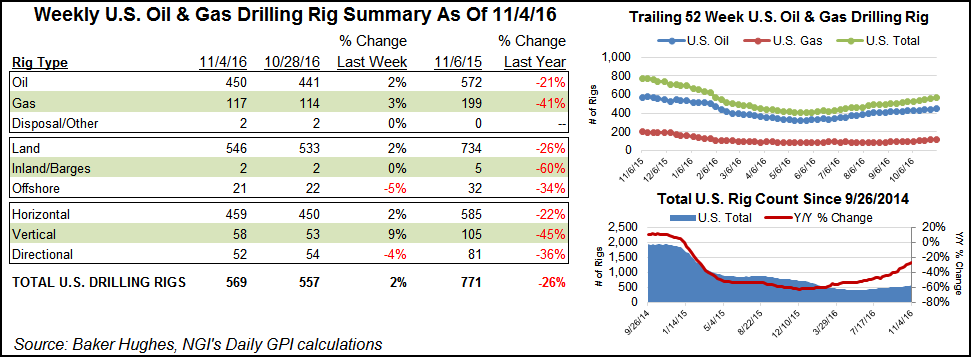E&P | NGI The Weekly Gas Market Report
Three NatGas Rigs Come Back, Including Another in Haynesville Shale
Three U.S. natural gas rigs were added to play during the week ending Friday, according to Baker Hughes Inc. (BHI). But drillers still show a preference for the black stuff, as nine oil-directed rigs came back.

Texas was the leader among states adding drilling rigs. And it should surprise no one that the Permian Basin again led the pack of plays adding rigs.
The Permian added six rigs during the week to end at 218, not too far off its year-ago tally of 232 rigs running. The Delaware sub-basin saw the return of five rigs to end at 97. The Midland sub-basin added two to end at 116, and the “other Permian” category dropped one to leave five rigs still active.
Texas might be coming back, but like the other producing states and the rest of the industry, the Lone Star State is still far from the drilling activity seen during the boom days. September was the 22nd consecutive month that saw a decline in the Texas Petro Index, a barometer of the state’s upstream oil and natural gas activity (see Shale Daily, Nov. 2). The recovery is a slow one.
More broadly, another indicator of the drilling slump’s staying power is the fact that North American well costs are down an estimated 40% compared with where they were in 2014, according to Barclays Commodities Research. “The oilfield service sector is still swimming in excess equipment inventory,” Barclays said in an Oct. 30 note on what was heard at its recent Corporate Energy Conference in Austin. “For example, current supply of frac horsepower is around 17 million hp, but the market currently demands only about 4 million hp.”
Elsewhere in the energy patch, Oklahoma followed Texas in rig gains, adding three units. Notably static during the week were the Marcellus and Utica shales, among others. One more rig crept back to the Haynesville, though, bringing its total to 21 active (see Daily GPI, Oct. 28).
Overall, the United States added 13 land rigs, offset by the decline of one from the offshore for a net gain of 12 to end at 569. Add Canada’s net gain of one rig to a total of 154, and the North American tally stood at 723 at week’s end.
Two directional rigs left, but nine horizontals and five verticals came back. In Canada, three oil rigs came back, offset by the departure of two gas rigs.
© 2024 Natural Gas Intelligence. All rights reserved.
ISSN © 1532-1231 | ISSN © 1532-1266 |
